|
The native giant red sea cucumber (Parastichopus californicus) ranges from southern California to the Gulf of Alaska. It feeds on decaying organic matter, bacteria and benthic diatoms that occur in or on the seabed. The wild fishery for P. californicus is declining in Alaska and Washington, with a first ever closer in Puget Sound in 2014 and the initiation of a license buy-back program in 1999 to reduce harvest. This species of sea cucumber is in high demand in China due to its similar characteristics to the native Chinese species, presenting an opportunity to culture the species in the U.S. for export and reduce harvest pressure on wild populations.
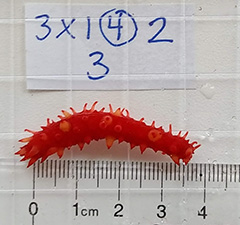
Individual sea cucumbers can be identified by the unique arrangement of spines on the dorsal and lateral sides of the animal. Featured here, a baby Parastichopus being monitored for growth during a nursery feeding trial. Photo: Aimee Christy
This research will develop methods to co-culture P. californicus underneath currently farmed species (e.g. salmonids, sable fish, mussels) in Alaska (Ketchikan) and Washington (Rich Passage and Quilcene Bay), utilizing the sea cucumbers as nutrient recyclers, feeding on the waste products from the co-cultured organisms growing above them. The team leaders for this research include: Andrew Suhrbier (PI) at Pacific Shellfish Institute, Brent Vadopalas and Lorenz Hauser from the University of Washington, Jeff Hetrick from Alutiiq Pride Shellfish Hatchery in Seward, AK, Ryan Crim from the Puget Sound Restoration Fund, and Henry Carson from WA Dept. of Fish & Wildlife. This research was supported by the NOAA Saltonstall-Kennedy program (grant no. #2004246) during FY2015-2019.
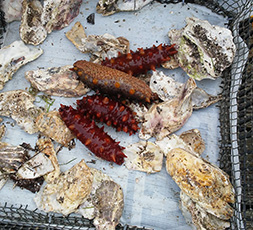
Sea cucumbers in custom trays designed to protect animals from predators and prevent any cucumbers from escaping during grow out. Photo: Katie Houle
Research began with the collection of wild P. californicus specimens living subtidally and among shellfish aquaculture gear in Washington, Alaska and California for population genetic analysis and for grow-out experiments in the first year. Genetic analyses were used to determine whether spatially distinct populations of P. californicus occurred prior to out-planting activities. Additional specimens were collected as broodstock from Puget Sound and transferred to the Kenneth K. Chew Center for Shellfish Research and Restoration (KKCCSRR) in Port Orchard, WA for the development of culture techniques by staff at the Puget Sound Restoration Fund and the Alutiiq Pride Shellfish Hatchery in Seward, AK.
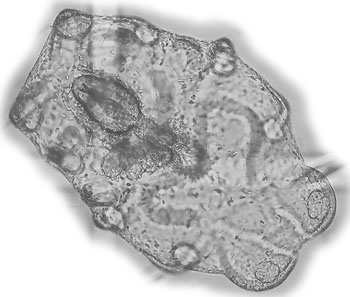
The non-feeding pelagic larval stage (doliolaria) just before metamorphosis into a benthic juvenile. Photo: PSRF.
The following Final Report 2019 (pdf) documents the research activities from FY2015-2019 including: population genetics, comparative co-culture grow out trials and hatchery development for native P. californicus.
PSI led research of polyculture methods for P. californicus continues, FY18-FY20 with funding from Pacific States Marine Fisheries Commission. Project partners include: Andrew Suhrbier (PI) at PSI, Jodie Toft and Ryan Crim at PSRF, John Colt and William Fairgrieve (NOAA) and Diane Boratyn at SOLSEA farms. This research is focused on the nursery stage, a critical link between hatchery and grow-out. Objectives include determining optimal food sources, delivery, feeding rates and stocking densities for juvenile sea cucumbers to accelerate growth at the nursery stage, shortening total grow-out time. Initial feeding trials have shown some promising results with diets including macroalgae and mussel waste. The research team aims to test the feasbility of the systems developed for this species at commerical scale.
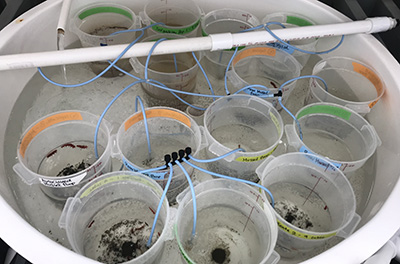
Diet trials are underway at the PSRF nursery to determine the best feeds and delivery methods to optimize juvenile sea cucumber growth. Photo: Isabel Platten
Project Partners:
Project Summary (printable 1-pg PDF)
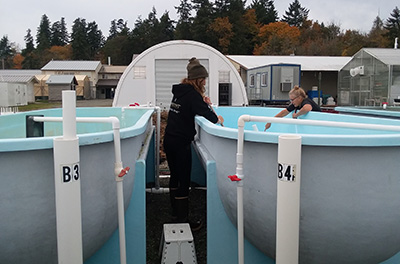
Cleaning commerial tanks for co-culture grow-out at SOLSEA. Behind, nursery and hatchery facilities run by project partners, Puget Sound Restoration Fund, where sea cucumbers and other native shellfish species are reared at the Kenneth K. Chew Center for Shellfish Research and Restoration NOAA facility in Manchester, WA.
|
|
Mercier, A., Hamel, J. F., Suhrbier, A., Pearce, C. (Eds.). (2023). The World of Sea Cucumbers: Challenges, Advances and Innovations. Academic Press.
Vassili, a professional sea cucumber diver, about to take the plunge in Manchester, WA in search of more broodstock for our hatchery.
Andy Suhrbier (PI) lowers trays of sea cucumbers below sablefish growing at the NOAA Manchester Facility in Washington.
Commercial grade dulse growing in co-culture with P. californicus at SOLSEA farms land-based system in Manchester, WA (photo below).
PSI biologist, Katie Houle, tests the water quality in co-culture trials of macroalgae and P. californicus. The sea cucumbers feed on diatoms and decaying algae in the tanks, while sea cucumber waste increases nutrients for macroalgal growth.
|
|













